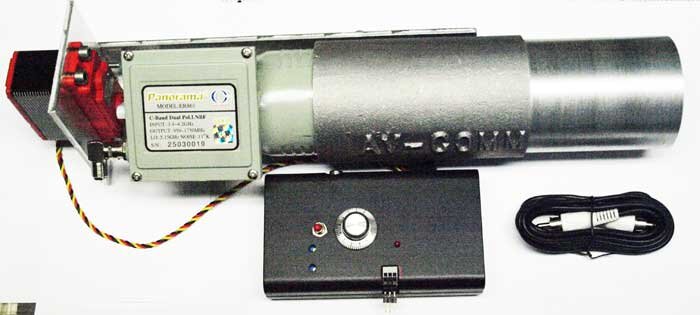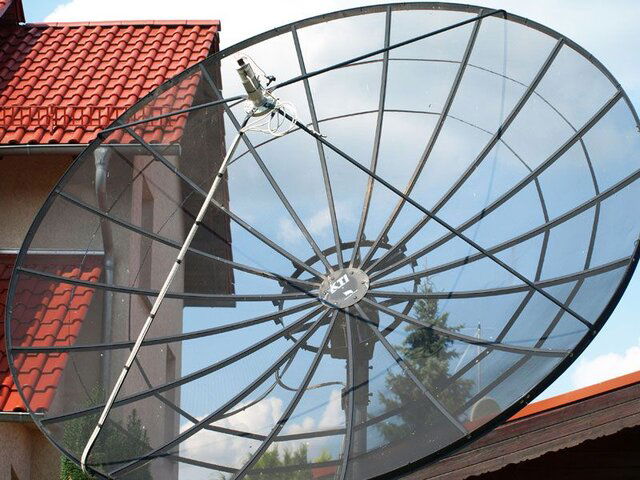Hi,
I have an opportunity to buy a secondhand Chapparal OMT feed for C-Band with two 17 K LNB's that is meant to be used for linear C-Band reception. So horizontal and vertical.
However, I live in Europe where just about all C-Band satellites of interest to me broadcast in circular mode, LHCP and RHCP.
At present I use a very good CalAmp feed that was recommended here as being superior to the Chapparal feed and a Norsat C-Band LNB type 8515, again, recommended to me here.
The disadvantage is of course that I need to use an old analog Echostar receiver to change polarizations, the advantage is that I can use the skewing option for the most perfect signal. But it sure would be attractive if I no longer needed to skew or change polarity manually.
Now I don't know how this is seen in publications from the USA, but here lately people use what's called a "studs" solution als an alternative to using a dialectricum like I do to get circular polarized signals. But it seems to me that using a dialectricum on a fixed OMT with two LNB's wouldn't work.
Normally this solution is carried out rather rudimentarily by sticking a plastic bottle with studs at exactly calculated positions into the feed. However, the person who figured this out old me that although theoretically this should also work with a dual LNB OMT like this (the seller speaks of a Bull OMT but I don't find this back in that context) he also told me that he is not aware that anyone ever was able to apply this studs-solution succesfully in such a system, that he only knows it to work in a regular feed.
Can anyone tell me what's wisdom? An extra complication is that the guy wants to sell the OMT without the matching scalar rings because he wants to use those himself for another project. I know of two types of Chapparal scalar rings (one type had deeper rings than the other) which of course complicates the issue even further for me.
Should I risk it and buy, or should I not mess with a good working system and accept that polarity is something that I juist have to do manually with a separate contraption? Or is there such a thing as a dual C-Band LNB system that's made for circular and linear polarization? What's wisdom in this matter, I hate to buy gear for good money that ends up in the trash can or tool box...
I have an opportunity to buy a secondhand Chapparal OMT feed for C-Band with two 17 K LNB's that is meant to be used for linear C-Band reception. So horizontal and vertical.
However, I live in Europe where just about all C-Band satellites of interest to me broadcast in circular mode, LHCP and RHCP.
At present I use a very good CalAmp feed that was recommended here as being superior to the Chapparal feed and a Norsat C-Band LNB type 8515, again, recommended to me here.
The disadvantage is of course that I need to use an old analog Echostar receiver to change polarizations, the advantage is that I can use the skewing option for the most perfect signal. But it sure would be attractive if I no longer needed to skew or change polarity manually.
Now I don't know how this is seen in publications from the USA, but here lately people use what's called a "studs" solution als an alternative to using a dialectricum like I do to get circular polarized signals. But it seems to me that using a dialectricum on a fixed OMT with two LNB's wouldn't work.
Normally this solution is carried out rather rudimentarily by sticking a plastic bottle with studs at exactly calculated positions into the feed. However, the person who figured this out old me that although theoretically this should also work with a dual LNB OMT like this (the seller speaks of a Bull OMT but I don't find this back in that context) he also told me that he is not aware that anyone ever was able to apply this studs-solution succesfully in such a system, that he only knows it to work in a regular feed.
Can anyone tell me what's wisdom? An extra complication is that the guy wants to sell the OMT without the matching scalar rings because he wants to use those himself for another project. I know of two types of Chapparal scalar rings (one type had deeper rings than the other) which of course complicates the issue even further for me.
Should I risk it and buy, or should I not mess with a good working system and accept that polarity is something that I juist have to do manually with a separate contraption? Or is there such a thing as a dual C-Band LNB system that's made for circular and linear polarization? What's wisdom in this matter, I hate to buy gear for good money that ends up in the trash can or tool box...






